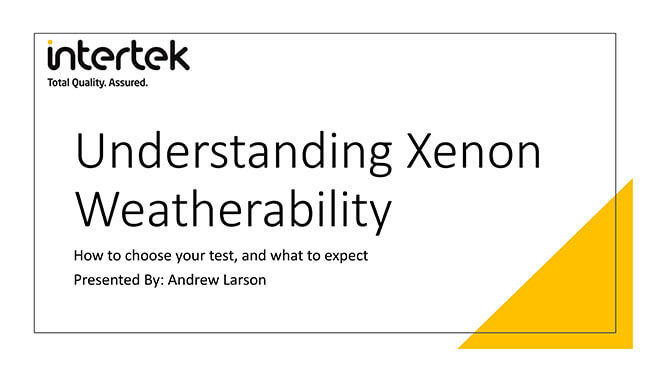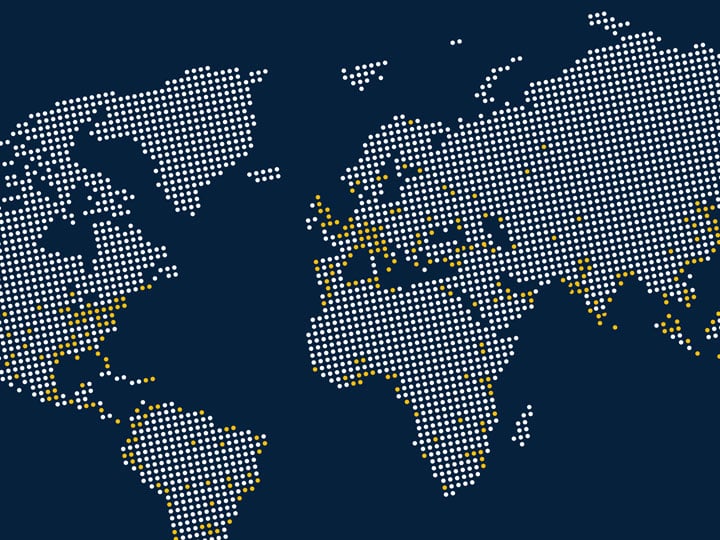Fluorescent UV exposure and Accelerated Xenon Arc testing for materials intended for indoor or outdoor applications
Accelerated weathering simulates the damaging effects of long term outdoor exposure of materials and coatings by exposing test samples to varying conditions of the most aggressive components of weathering - light, moisture, and heat. A Weather-Ometer uses a light source to provide a radiation spectrum that simulates natural sunlight, while glass filters around the xenon arc modify the light spectrum to simulate the appropriate end use conditions. Moisture is provided by a humidifier and direct spray, and temperature is controlled by heaters. Microprocessors monitor and precisely control the amount of radiation applied to the test samples.
Accelerated weathering testing can play a critical part of your product development. Testing the durable lifespan of products to accelerated weathering can be a challenge. Understanding the testing, results, and what it all means for your product can be a long journey. Our Intertek experts can help you with this process by making testing and evaluation recommendations for a variety of product applications. With more than 50 years of experience, we've seen nearly everything under the sun when it comes to accelerated weathering.
Accelerated weathering is among some of the longest duration tests in the testing industry. We understand that production timelines can be tight and delays due to equipment availability can be frustrating. Our labs have a large capacity for all types of accelerated weathering exposures. If we’re not already running what you need, we have a fleet of test cabinets ready to accommodate your products.
Common exposure used in Accelerated Light Weathering
Types of exposures:
- Fluorescent UV Exposure
- Florescent UV light sources, like a QUV, can provide irradiance control, temperature, condensing humidity control, and sometimes water spray. This exposures light is focused on the UV spectrum and differs from other types of accelerated weathering lamps.
- Specimens:
- Anywhere from 2" x 3" panels to 12" x 12" panels. Thickness is limited to 1" or less without cabinet modifications. Please contact the laboratory for custom size test specimens.
- Applications:
- Fluorescent UV is used in a variety of industries and has been a common test method for weathering over many years. Fluorescent UV testing is typically used a as baseline to determine color fastness and effects of UV light on samples in the early stages of development.
- Common Test Methods
- ASTM G154
- ASTM G151
- AATCC TM186
- ASTM D3451
- ISO 29664
- ISO 11507
- ISO 4892
- SAE J2020
- Accelerated Xenon-Arc
- Xenon-Arc chambers are today's most common method of accelerated light weathering used in the testing industry. Xenon chambers use xenon-arc lamps and controlled environments to replicate full spectrum sunlight and rain from outdoor exposure. These types of exposures can change results from years of outdoor exposure to just months. Using specific light filters and scientifically developed exposure profiles a wide variety of exposure environments can be recreated that best match your products actual use case lifespan.
- Specimens:
- Depending on the type of xenon weatherometer different test specimen sizes can be used. Traditionally 3" x 6" test panels are used in drum style and flatbed style chambers. Dimensions can vary up to 12" x 16" panes of glass or sheets of textiles for example.
- Often times production samples are not conducive to standard weatherometer set ups. Using 3D placement we can accommodate samples up to 4" thick in our flatbed chambers. If you have questions on samples size, please reach out to an Intertek weathering expert to talk about options.
- Common Test Methods
- AATCC TM16.3
- ASTM D7869
- ASTM G155
- ISO 105-B02
- ISO 105-B06
- ISO 4892-2
- SAE J2527
- SAE J2412
- Automotive OEM Specific Test Methods
- FLTM BO 116-01
- NES M0135
- PV3929
- PV3930
- PV1303
- TSH3130G
- TSL0601G
Data:
Accelerated weathering provides exposed samples for comparison to unexposed control samples. Often several exposure times (such as 500, 1000, and 2000 hours) also will be compared to each other. Depending upon the performance requirements of concern, such a comparison may involve measurements of Haze, Transmission, Yellowness Index, Color Change, and/or physical properties such as Impact Strength.
Test Industries:
Knowledge Center
Master FMVSS 108 Compliance – Download the Expert Guide
Automotive Functional Safety & Cyber Security FAQs
Development of Driveline Electrification Technologies White Paper
Understanding Failure Analysis and Answering your Frequently Asked Questions
The Top-7 FAQs of Autonomous Vehicles Testing
The Top-10 FAQs of Advanced Composites Testing
The Top-10 FAQs of Automotive Interior Testing
Accelerated Stress Testing to Manage Disruptive Market Changes Webinar
Transitioning to Structural Composites to Meet CAFE Standards
Automotive Interiors Testing White Paper
Resources
Global Research & Certification
SatelliteTM Client Test Program
Engineering and Technical Staffing
SupplyTek - gain the confidence to go to market faster
Protek - safeguard people, systems and processes, facilities, materials and surfaces, and products


